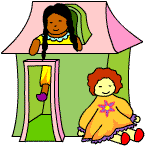Dolls' Houses
Created | Updated Jan 28, 2002

Dolls' houses and miniature collection are currently enjoying a world-wide resurgence in popularity. You can own your dream home complete with working lights and even running water at the fraction of the cost of a full-size property. Collectors say its attraction as a hobby lies in the fact that you can create your ideal residence and retain complete control over the inhabitants' destiny. There is also an innate charm in a perfectly formed miniature you can hold in the palm of your hand.
The first recorded evidence of a doll's house is from 1558 when Albrecht V, Duke of Bavaria ordered one to be built for his daughter. It was four storeys high with cowsheds and a garden. When the Duke took delivery of his daughter's present, he was so pleased with it that he claimed it for himself; presumably she was never allowed to play with it. Unfortunately the house no longer exists having been destroyed in a fire in the 1670s. Other miniatures have been discovered which pre-date this house and its contents; but doubt still remains whether they were toys or devotional items used in religious ceremonies.
In the 17th and 18th Centuries, cabinet and baby houses were popular in Europe. Both types were faithful representations of contemporary life and fashions. Cabinet houses were grand pieces of furniture with tiny rooms laid out behind glass doors. Baby houses tended mainly to be miniature versions of their owners' houses. Some of their furniture was commissioned, while other items were made by the ladies of the house to pass the time and to display their accomplishments, in much the same way that Victorian ladies embroidered any available surface to show off their skill. They were also a status symbol, indicating the wealth of the household. Examples of these houses can be seen at the Museum of London and the Bethnal Green Museum of Childhood.
By the 19th Century, doll's houses were commercially produced for children and regarded mainly as toys. Queen Victoria had a mass produced house, of which she was passionately fond. They remained the province of the nursery until 1924, when a house was built and furnished by British craftsmen and presented to Queen Mary. It was perfect down to the last detail, with books hand-written by Conan-Doyle in the Library and a cellar filled with corked and sealed bottles of vintage wine. This is now the property of Queen Elizabeth II and is available for public viewing at Windsor Castle.
Dolls' houses have come back into fashion slowly over the last 20 years. The scale, which used to vary from house to house, has been standardised to 1/12th or one inch to the foot. Some collectors with less room or too many houses are also reviving 1/16th and 1/24th scale. There are now numerous fairs for enthusiasts every year, as well as magazines, shops and clubs. Most collectors prefer nostalgia to representations of how we live now, Victorian houses and furnishings proving to be the most popular. This is mainly due to the fact that the Victorians loved clutter, so you always have an excuse to buy 'just one more thing' for your collection. It does however, seem a shame that no one is going to leave behind a perfect record of life at the start of the 21st Century.

